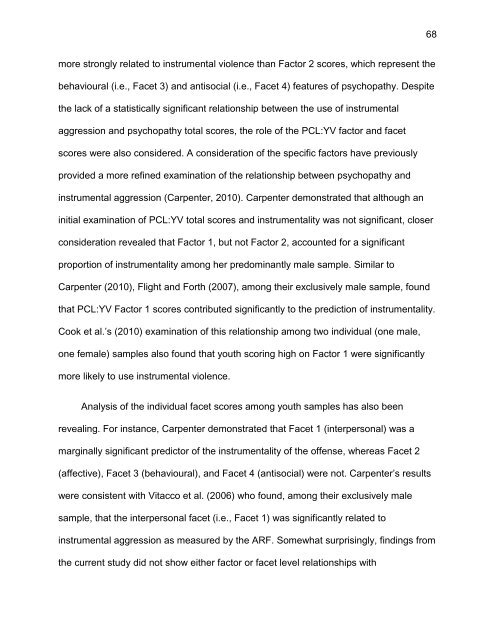an examination of the factor structure of the psychopathy checklist
an examination of the factor structure of the psychopathy checklist
an examination of the factor structure of the psychopathy checklist
Create successful ePaper yourself
Turn your PDF publications into a flip-book with our unique Google optimized e-Paper software.
more strongly related to instrumental violence th<strong>an</strong> Factor 2 scores, which represent <strong>the</strong><br />
behavioural (i.e., Facet 3) <strong>an</strong>d <strong>an</strong>tisocial (i.e., Facet 4) features <strong>of</strong> <strong>psychopathy</strong>. Despite<br />
<strong>the</strong> lack <strong>of</strong> a statistically signific<strong>an</strong>t relationship between <strong>the</strong> use <strong>of</strong> instrumental<br />
aggression <strong>an</strong>d <strong>psychopathy</strong> total scores, <strong>the</strong> role <strong>of</strong> <strong>the</strong> PCL:YV <strong>factor</strong> <strong>an</strong>d facet<br />
scores were also considered. A consideration <strong>of</strong> <strong>the</strong> specific <strong>factor</strong>s have previously<br />
provided a more refined <strong>examination</strong> <strong>of</strong> <strong>the</strong> relationship between <strong>psychopathy</strong> <strong>an</strong>d<br />
instrumental aggression (Carpenter, 2010). Carpenter demonstrated that although <strong>an</strong><br />
initial <strong>examination</strong> <strong>of</strong> PCL:YV total scores <strong>an</strong>d instrumentality was not signific<strong>an</strong>t, closer<br />
consideration revealed that Factor 1, but not Factor 2, accounted for a signific<strong>an</strong>t<br />
proportion <strong>of</strong> instrumentality among her predomin<strong>an</strong>tly male sample. Similar to<br />
Carpenter (2010), Flight <strong>an</strong>d Forth (2007), among <strong>the</strong>ir exclusively male sample, found<br />
that PCL:YV Factor 1 scores contributed signific<strong>an</strong>tly to <strong>the</strong> prediction <strong>of</strong> instrumentality.<br />
Cook et al.’s (2010) <strong>examination</strong> <strong>of</strong> this relationship among two individual (one male,<br />
one female) samples also found that youth scoring high on Factor 1 were signific<strong>an</strong>tly<br />
more likely to use instrumental violence.<br />
Analysis <strong>of</strong> <strong>the</strong> individual facet scores among youth samples has also been<br />
revealing. For inst<strong>an</strong>ce, Carpenter demonstrated that Facet 1 (interpersonal) was a<br />
marginally signific<strong>an</strong>t predictor <strong>of</strong> <strong>the</strong> instrumentality <strong>of</strong> <strong>the</strong> <strong>of</strong>fense, whereas Facet 2<br />
(affective), Facet 3 (behavioural), <strong>an</strong>d Facet 4 (<strong>an</strong>tisocial) were not. Carpenter’s results<br />
were consistent with Vitacco et al. (2006) who found, among <strong>the</strong>ir exclusively male<br />
sample, that <strong>the</strong> interpersonal facet (i.e., Facet 1) was signific<strong>an</strong>tly related to<br />
instrumental aggression as measured by <strong>the</strong> ARF. Somewhat surprisingly, findings from<br />
<strong>the</strong> current study did not show ei<strong>the</strong>r <strong>factor</strong> or facet level relationships with<br />
68


















